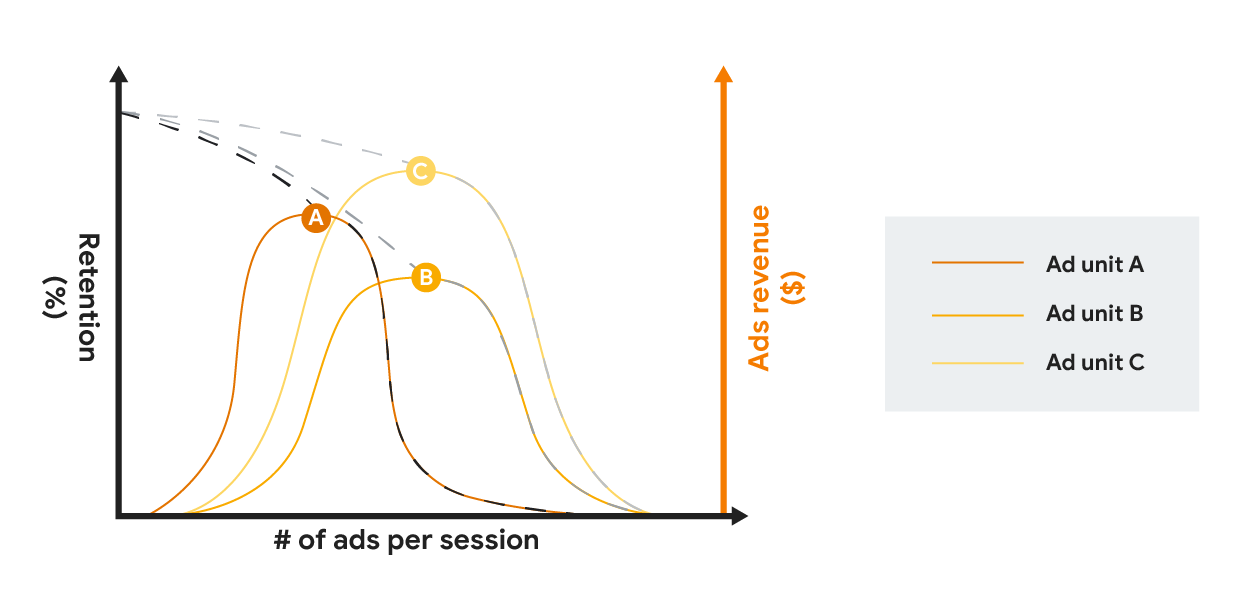نظرة عامة على الحلّ
ما هو اختبار اعتماد أشكال الإعلانات؟
سواء كان تطبيقك يحقّق أرباحًا مختلطة أو أرباحًا من الإعلانات، قد يكون من الصعب استخدام أشكال إعلانات مختلفة.
قد لا تناسب بعض أشكال الإعلانات كل تطبيق، وقد تحقّق بعض أشكال الإعلانات أداءً أفضل استنادًا إلى خصائص التطبيق. عند تنفيذ شكل إعلان جديد، قد يقلقك التأثير السلبي في تجربة المستخدم أو الاحتفاظ به، ولكن قد يقلقك أيضًا ما إذا كان بإمكانك زيادة الأرباح والتفاعل إذا تم استخدام شكل إعلان جديد بشكل صحيح.

لحلّ هذه المشاكل، يوفّر Firebase أدوات تساعدك في اختبار أشكال الإعلانات الجديدة ثم اتّخاذ قرارات مستندة إلى البيانات بشأن اعتمادها:
باستخدام Firebase، يمكنك إجراء اختبار أ/ب لأداء شكل إعلان جديد مع مجموعة فرعية صغيرة من المستخدمين.
يمكنك مراقبة نتائج الاختبار ومراجعة الاقتراحات من Firebase بشأن ما إذا كان أداء تنسيق الإعلان الجديد أفضل من تنسيق الإعلان الحالي.
بعد التأكّد من أنّ التغييرات ستؤدّي على الأرجح إلى تأثير إيجابي، يمكنك طرح التغييرات على المزيد من المستخدمين بنقرة زر واحدة.
دراسة الجدوى والقيمة
في المتوسّط، يحقّق المطوّرون والناشرون الذين يستخدمون أدوات Google AdMob وFirebase لإضافة شكل إعلان جديد زيادة كبيرة في الأرباح (تصل إلى 10 أضعاف*) مع الحفاظ على ثبات معدّل الاحتفاظ بالمستخدمين.
*زيادة الأرباح استنادًا إلى نتائج 8 ناشرين كبار في عام 2020

|
تستخدم شركة Pomelo Games Firebase لزيادة الأرباح بنسبة تصل إلى% 35 بدون خسارة اللاعبين. |

|
تستخدم شركة Qtonz Firebase لتسجيل زيادة بمقدار 4 أضعاف في أرباح الإعلانات وزيادة بنسبة 190% في متوسط الأرباح لكل مستخدم نشط يوميًا (ARPDAU). |
تنفيذ الحلّ
لتنفيذ هذا الحل، يمكنك اتّباع الدليل التعليمي المفصّل (يمكنك الاطّلاع على نظرة عامة على هذا الدليل التعليمي في وقت لاحق من هذه الصفحة).
في هذا الدليل التعليمي المكوّن من عدّة خطوات، ستتعرّف على كيفية استخدام Firebase لاختبار شكل إعلان جديد Google AdMob لتطبيقك. ويستخدم الدليل مثالاً لإطار اختبار يتضمن إعلانًا بينيًا يضم مكافأة، ولكن يمكنك الاستنتاج واستخدام الخطوات نفسها لمحاولة اختبار أشكال إعلانات أخرى.
يفترض هذا الدليل التعليمي أنّك تستخدم AdMob في تطبيقك وأنّك تريد اختبار ما إذا كانت إضافة وحدة إعلانية أخرى (باستخدام شكل إعلان جديد) ستسبب تأثيرًا في أرباح تطبيقك أو مقاييس أخرى. ومع ذلك، إذا لم تكن تستخدم AdMob في تطبيقك، لا بأس. يمكن أن تساعدك الخطوات الواردة في هذا الدليل التعليمي أيضًا في معرفة ما إذا كانت إضافة وحدة إعلانية إلى تطبيقك تؤثر في مقاييس تطبيقك.
المنتجات والميزات المستخدَمة في هذا الحلّ
|
Google AdMob تتيح لك أداة Google AdMob إنشاء صيغ لوحدة الإعلان سيتم عرضها داخل تطبيقك. عند ربط AdMob بمنصّة Firebase، تُرسِل أداة AdMob معلومات أرباح الإعلانات إلى Firebase لتحسين الاستراتيجية الإعلانية. Google Analytics Google Analytics تمنحك إحصاءات حول مقاييس تفاعل المستخدمين والحفاظ عليهم وتحقيق الربح، مثل إجمالي الأرباح، أرباح AdMob، وأرباح عمليات الشراء، وغير ذلك الكثير. ويسمح لك أيضًا ب إنشاء شرائح جمهور وشرائح مستخدِمين. |
Firebase Remote Config تتيح لك أداة Firebase Remote Config تغيير سلوك تطبيقك ومظهره وتخصيصهما ديناميكيًا لشرائح المستخدمين المطلوبة، وكل ذلك بدون نشر إصدار جديد من تطبيقك. في هذا الدليل التعليمي، ستستخدم مَعلمات Remote Config للتحكّم في ما إذا كان سيتم عرض وحدة إعلانية جديدة للمستخدمين. Firebase A/B Testing توفّر أداة Firebase A/B Testing الواجهة والبنية الأساسية لإجراء تجارب المنتجات والتسويق في تطبيقك. وتتولى توزيع الأسعار المتغيرة للتجربة على المستخدمين، ثمّ تُجري تحليلاً إحصائيًا لتحديد ما إذا كانت الأسعار المتغيرة للتجربة تحقّق أداءً أفضل مقارنةً بالمجموعة الضابطة استنادًا إلى المقياس الرئيسي الذي اخترته، مثل الأرباح أو الاحتفاظ بالمستخدمين. |

نظرة عامة على الدليل التوجيهي لحلّ المشاكل
الانتقال مباشرةً إلى البرنامج التعليمي المفصّل
استخدِم AdMob ل إنشاء صيغة وحدة إعلانية جديدة للاختبار.
أنشئ وحدة إعلانية بينية جديدة بمكافأة في AdMob.
نفِّذ موضع الوحدة الإعلانية في رمز تطبيقك.
إعداد اختبار A/B في وحدة تحكّم Firebase
حدِّد أساسيات الاختبار والاستهداف والأهداف التي سيتم تنفيذ الاختبار ضدها.
حدِّد الصيغ الاختبارية وإعداد المَعلمة Remote Config التي ستتحكّم في ما إذا كان سيتم عرض الوحدة الإعلانية الجديدة للمستخدمين في الاختبار.
معالجة Remote Config قيم المَعلمات في رمز تطبيقك
استخدِم المَعلمة Remote Config في تطبيقك.
نفِّذ منطق عرض الوحدة الإعلانية استنادًا إلى قيمة المَعلمة.
بدء اختبار A/B ومراجعة نتائج الاختبار في وحدة تحكّم Firebase
بعد بدء الاختبار والسماح بتنفيذه لبضعة أيام أو أسابيع، تحقّق من وحدة تحكّم Firebase لمعرفة ما إذا كان اختبار أ/ب يتضمّن صيغة فائزة استنادًا إلى الهدف الأساسي لاختبار أ/ب.
راجِع تأثير كلّ صيغة على المقاييس الثانوية للتأكّد من أنّه لم تتسبّب الصيغ في تأثيرات سلبية غير مقصودة على هذه المقاييس.
تحديد ما إذا كان سيتم طرح شكل الإعلان الجديد
إذا تبيّن A/B Testing أنّ الصيغة التي تعرض شكل الإعلان الجديد هي الفائزة، يمكنك بدء عرض شكل الإعلان لجميع المستخدِمين المستهدَفين في التجربة أو جميع مستخدِمي تطبيقك أو لمجموعة فرعية من مستخدِميك.
إذا لم يتم تحديد حملة فائزة بوضوح، يمكنك مواصلة تنفيذ التجربة لجمع المزيد من البيانات أو إنهاء التجربة إذا كانت قيد التنفيذ لفترة طويلة مع نتائج غير حاسمة.

